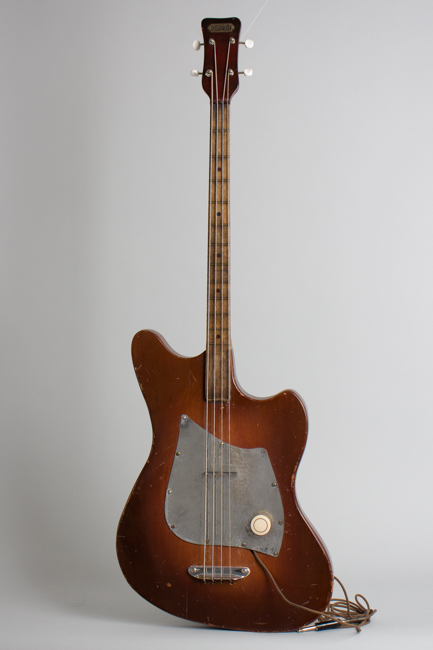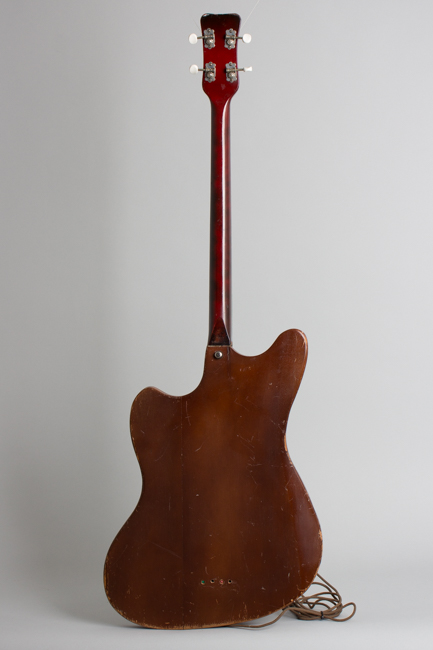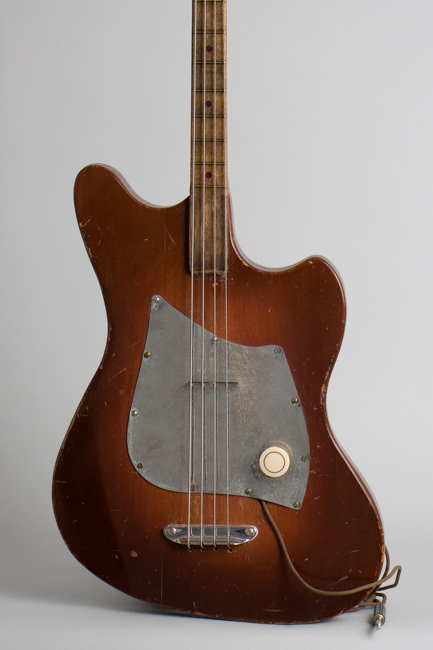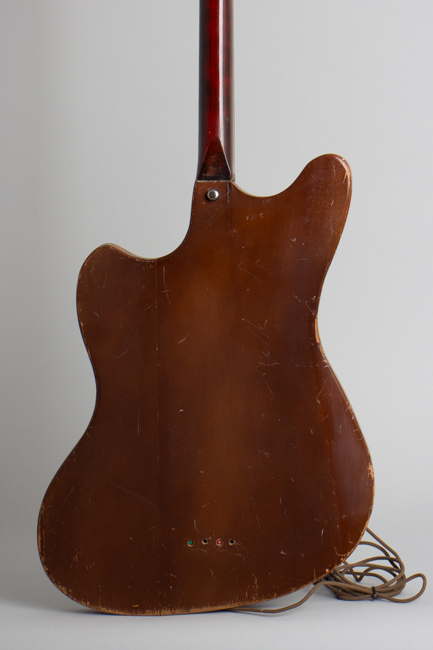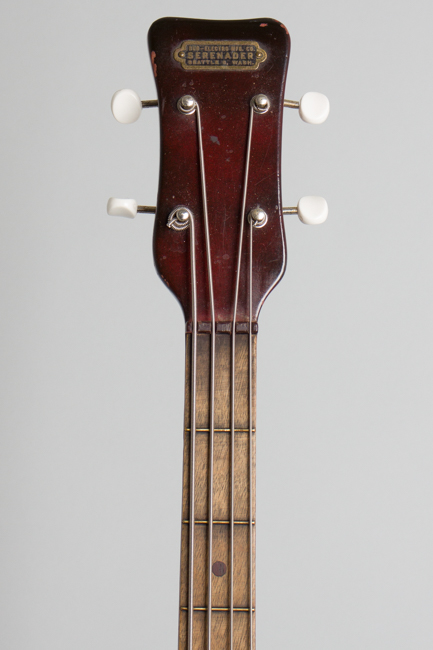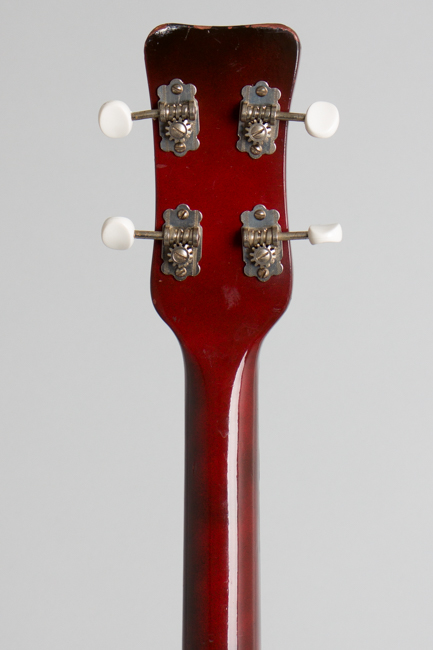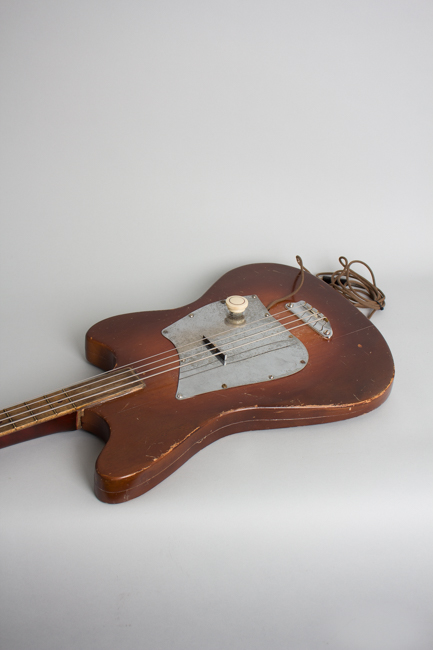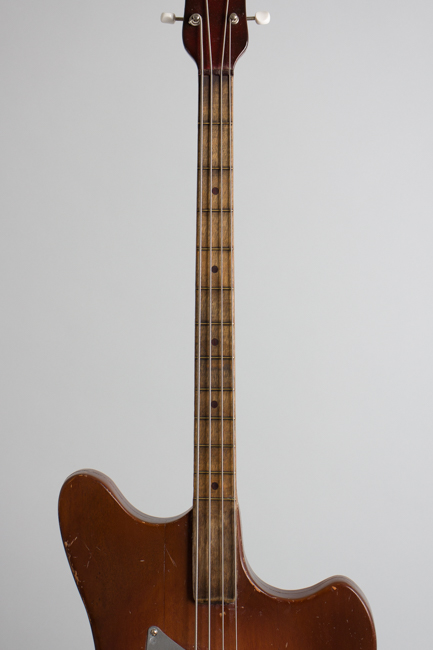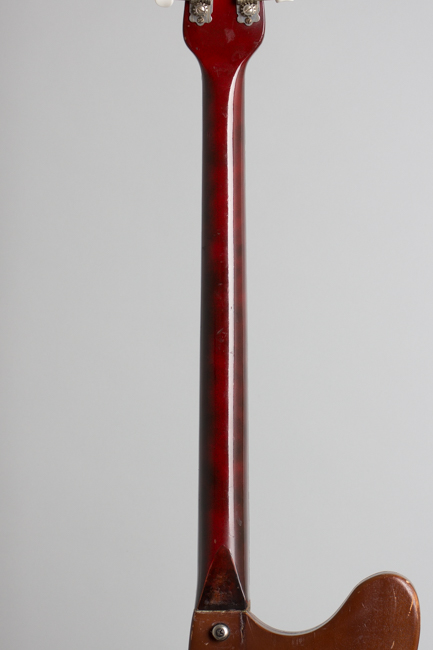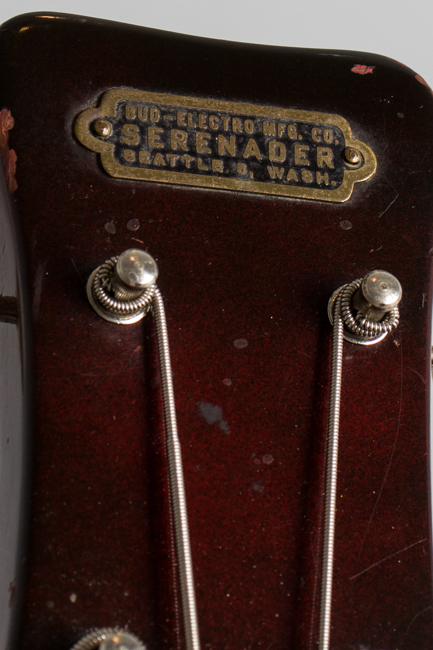Bud-Electro Serenader Solid Body Electric Bass Guitar , c. 1940s/1960s
Bud-Electro Serenader Model Solid Body Electric Bass Guitar, c. 1940s/1960s, made in Seattle, WA, sunburst finish, hardwood body and neck, dyed maple fingerboard, black gig bag case.
We have seen a lot of oddball instruments over the last few decades, but this is one of the oddest. This small (and fairly conventionally shaped) electric bass is actually the tip of a historical iceberg very little appreciated in the 21st century. It also poses as many questions as it answers; although we can say for sure WHERE it was made, the "WHEN" is less certain. The best guess is this instrument is a hybrid, built with a 1940s Bud-Electro Bass neck, bridge and pickup assembly mounted on a body fashioned by Bud Tutmarc sometime after 1958. That, or Bud actually invented the Fender Jazzmaster offset body!
"Serenader-Bud-Electro Mfg. Co." is on the headstock plate, along with its birthplace of Seattle, Washington. This a is largely forgotten direct descendant of the 1930s Audiovox Bass, the world's first electric bass guitar. Starting around 1932 Seattle teacher/inventor Paul Tutmarc made some of the earliest electric steels, but his most prescient invention was doomed to near total obscurity. A February 17, 1935 news article showed Tutmarc demonstrating a solid body cello-like electric bass noting "You pluck a string - and out of the electric amplifier comes a rich, deep tone... sustained as long as you want it"
Tutmarc's Audiovox company began marketing his more guitar-like #736 Electronic Bass in the Spring of 1937 featuring the magnetic pickup he and Arthur J. Stimson concocted as early as 1931. Stimson independently patented and sold the design to Dobro in Los Angeles for their 1933-4 All-Electric model, while Tutmarc soldiered on alone in Seattle. Although small and oddly shaped the Audiovox #736 was the world's first electric bass made to be played guitar-style. Rickenbacker, Vega and even Gibson experimented with upright electric basses in the 1930s, but only the Audiovox bass was designed to be held and played like a guitar.
Around 1947 Tutmarc's son Bud began marketing a similar bass under the Serenader brand name, even arranging distribution through northwest jobber L. D. Heater. It appeared in their 1948 catalog, but apparently garnered little interest. The Serenader Bass retained the small abstractly shaped minimalist body of the 1930s Audiovox, which essentially looked like one of Tutmarc's lap steels with a long neck attached. It was not only awkward looking but not particularly convenient to hold in playing position, something Leo Fender was careful to get right.
All of which brings us to this Bud-electro Bass. It's possible this was fashioned for a local student and/or customer of Bud Tutmarc (practically all these were sold locally) who was a sale prospect for the bass, but objected to the body shape. Or perhaps Bud was just idly experimenting with an unsold bass left languishing around the place. What resulted is the slim, 29 1/2" scale neck, crude pickup assembly and cast metal bridge of a 1940s Bud bass with a later body fashioned by him, likely in the early 1960s. How do we know Bud made it? If you've ever seen his routing style, it is distinctive to say the least!
The VERY thin neck has a short 29 1/2" scale length and only 12 frets, topped by a small headstock with four openback guitar tuners. The rather crude handmade blade-pole pickup has a large internal horseshoe magnet, and is little changed from the original 1930s design including the integral cloth cord and single large white plastic radio knob. The bridge is a piece of cast brass chrome plated, with the strings running through the body behind it.
The body itself is made of laminated hardwood, professionally cut out and finished in a subtle dark sunburst. It appears to have been traced closely from a Fender Jazzmaster of Jaguar (unless you choose to believe Leo stole the shape from Bud Turmarc!). The neck and body are visibly from different periods, and rather crudely joined together; the finish on the neck is a heavier and more professional looking lacquer. There is no lower strap button; the bass was likely intended to be played sitting down.
Whatever the genesis of this bass, it remains a fascinating historical artifact, one of the few Tutmarc basses known to exist and a unique one at that. It is fully playable, with a good sound although not really comparable to a Fender bass. A mystery wrapped in an enigma, this quizzical bass is a fretted oddity par excellence!
Overall length is 39 in. (99.1 cm.), 14 in. (35.6 cm.) wide at lower bout, and 1 1/2 in. (3.8 cm.) in depth, measured at side of rim. Scale length is 29 1/2 in. (749 mm.). Width of nut is 1 1/4 in. (32 mm.).
This is a playable instrument, but primarily of historical interest. The body and neck are solidly but somewhat crudely attached, with a small sealed crack at the body end and visible gap at the bass side join. There is general wear overall more to the body than the neck, and the dyed maple fingerboard has lost most of its toner. There is a decent amount of corrosion to the metal pickguard, and some of the screws are mismatched. The bass plays well as a low-tension instrument (similar to a Danelectro) and has a surprisingly powerfiul sound from its very primitive looking pickup, which appears all original. We'd rate this primarily as a historical oddity, but a dang interesting one! Overall Very Good + Condition.
We have seen a lot of oddball instruments over the last few decades, but this is one of the oddest. This small (and fairly conventionally shaped) electric bass is actually the tip of a historical iceberg very little appreciated in the 21st century. It also poses as many questions as it answers; although we can say for sure WHERE it was made, the "WHEN" is less certain. The best guess is this instrument is a hybrid, built with a 1940s Bud-Electro Bass neck, bridge and pickup assembly mounted on a body fashioned by Bud Tutmarc sometime after 1958. That, or Bud actually invented the Fender Jazzmaster offset body!
"Serenader-Bud-Electro Mfg. Co." is on the headstock plate, along with its birthplace of Seattle, Washington. This a is largely forgotten direct descendant of the 1930s Audiovox Bass, the world's first electric bass guitar. Starting around 1932 Seattle teacher/inventor Paul Tutmarc made some of the earliest electric steels, but his most prescient invention was doomed to near total obscurity. A February 17, 1935 news article showed Tutmarc demonstrating a solid body cello-like electric bass noting "You pluck a string - and out of the electric amplifier comes a rich, deep tone... sustained as long as you want it"
Tutmarc's Audiovox company began marketing his more guitar-like #736 Electronic Bass in the Spring of 1937 featuring the magnetic pickup he and Arthur J. Stimson concocted as early as 1931. Stimson independently patented and sold the design to Dobro in Los Angeles for their 1933-4 All-Electric model, while Tutmarc soldiered on alone in Seattle. Although small and oddly shaped the Audiovox #736 was the world's first electric bass made to be played guitar-style. Rickenbacker, Vega and even Gibson experimented with upright electric basses in the 1930s, but only the Audiovox bass was designed to be held and played like a guitar.
Around 1947 Tutmarc's son Bud began marketing a similar bass under the Serenader brand name, even arranging distribution through northwest jobber L. D. Heater. It appeared in their 1948 catalog, but apparently garnered little interest. The Serenader Bass retained the small abstractly shaped minimalist body of the 1930s Audiovox, which essentially looked like one of Tutmarc's lap steels with a long neck attached. It was not only awkward looking but not particularly convenient to hold in playing position, something Leo Fender was careful to get right.
All of which brings us to this Bud-electro Bass. It's possible this was fashioned for a local student and/or customer of Bud Tutmarc (practically all these were sold locally) who was a sale prospect for the bass, but objected to the body shape. Or perhaps Bud was just idly experimenting with an unsold bass left languishing around the place. What resulted is the slim, 29 1/2" scale neck, crude pickup assembly and cast metal bridge of a 1940s Bud bass with a later body fashioned by him, likely in the early 1960s. How do we know Bud made it? If you've ever seen his routing style, it is distinctive to say the least!
The VERY thin neck has a short 29 1/2" scale length and only 12 frets, topped by a small headstock with four openback guitar tuners. The rather crude handmade blade-pole pickup has a large internal horseshoe magnet, and is little changed from the original 1930s design including the integral cloth cord and single large white plastic radio knob. The bridge is a piece of cast brass chrome plated, with the strings running through the body behind it.
The body itself is made of laminated hardwood, professionally cut out and finished in a subtle dark sunburst. It appears to have been traced closely from a Fender Jazzmaster of Jaguar (unless you choose to believe Leo stole the shape from Bud Turmarc!). The neck and body are visibly from different periods, and rather crudely joined together; the finish on the neck is a heavier and more professional looking lacquer. There is no lower strap button; the bass was likely intended to be played sitting down.
Whatever the genesis of this bass, it remains a fascinating historical artifact, one of the few Tutmarc basses known to exist and a unique one at that. It is fully playable, with a good sound although not really comparable to a Fender bass. A mystery wrapped in an enigma, this quizzical bass is a fretted oddity par excellence!
Overall length is 39 in. (99.1 cm.), 14 in. (35.6 cm.) wide at lower bout, and 1 1/2 in. (3.8 cm.) in depth, measured at side of rim. Scale length is 29 1/2 in. (749 mm.). Width of nut is 1 1/4 in. (32 mm.).
This is a playable instrument, but primarily of historical interest. The body and neck are solidly but somewhat crudely attached, with a small sealed crack at the body end and visible gap at the bass side join. There is general wear overall more to the body than the neck, and the dyed maple fingerboard has lost most of its toner. There is a decent amount of corrosion to the metal pickguard, and some of the screws are mismatched. The bass plays well as a low-tension instrument (similar to a Danelectro) and has a surprisingly powerfiul sound from its very primitive looking pickup, which appears all original. We'd rate this primarily as a historical oddity, but a dang interesting one! Overall Very Good + Condition.
